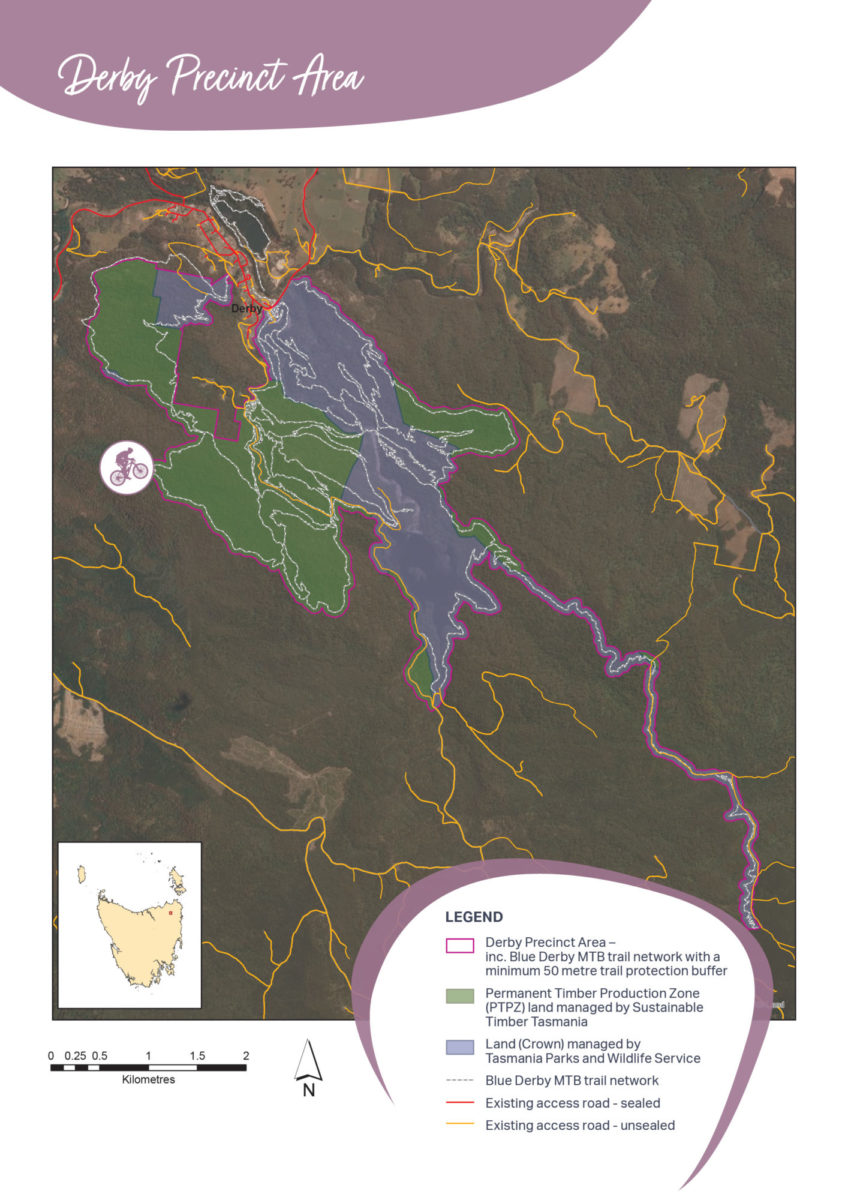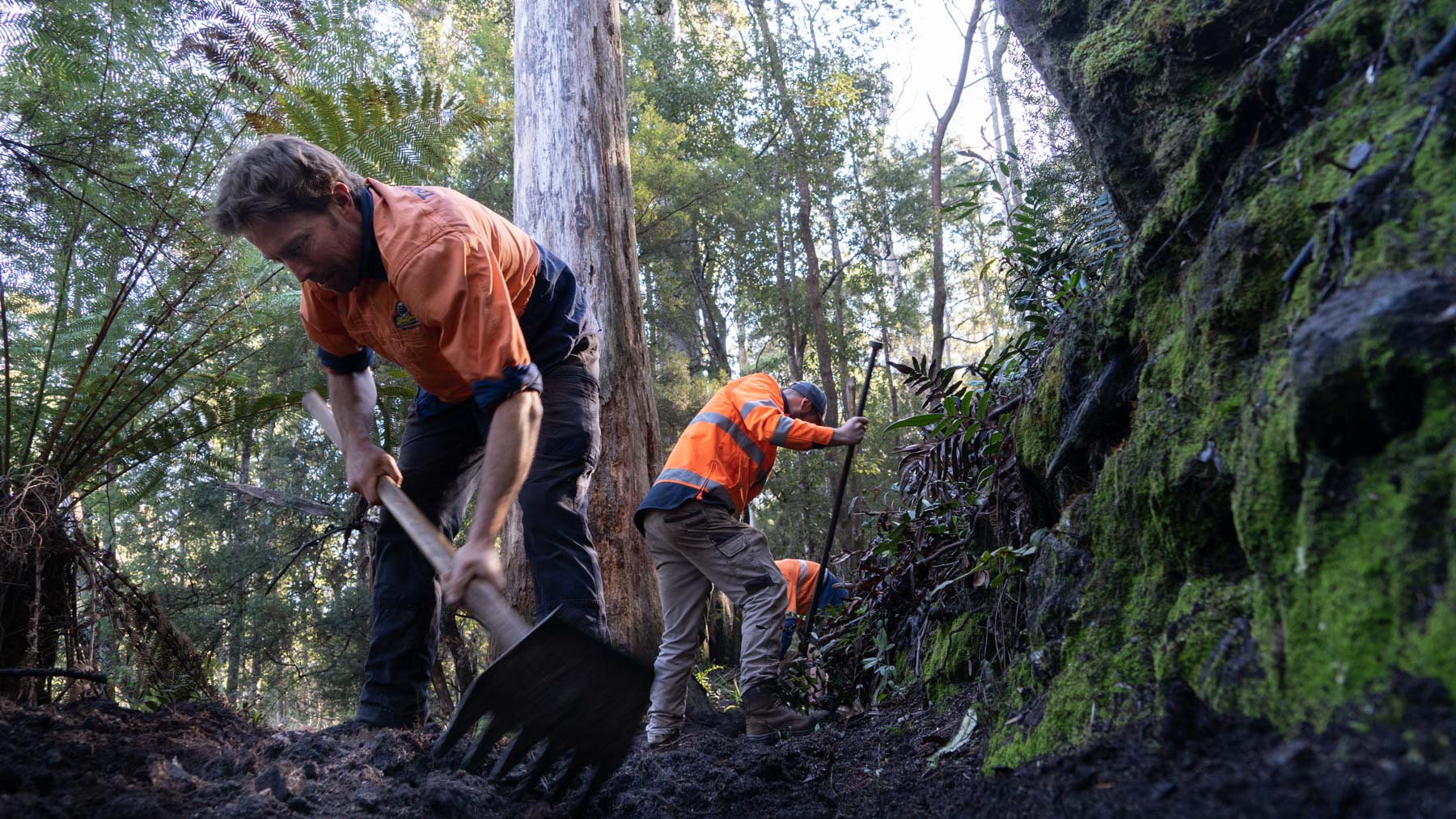Last year when we took a deep dive into what native logging means for Blue Derby, we learned that there was a plan in the works to encapsulate the footprint of Blue Derby into a reserve that would protect the trail network from logging.
As recently as January 21, 2022, Sustainable Timber Tasmania has confirmed to Flow that coupes CC105A near Krushka’s, and CC119A, which runs along the other side of Krushka’s and Dam Busters, are still scheduled to be harvested this year. However, we’ve just learned details of the Derby Precinct Concept Plan, which would permanently prevent harvesting activity inside the network.
Related:
- What does native logging mean for mountain biking in Derby?
- Maydena Bike Park is buzzing this summer: what’s new, what’s changed and what’s on
- Gravity trails on Mount George now open | George Town, Tas
What is the Derby Precinct Concept Plan?
The Blue Derby trail Network falls under several land tenures, but a significant portion is classed as a Permanent Timber Production Zone (PTPZ) or a Future Potential Production Forest (FPPF).
This is a jargony way of saying that all of these areas could potentially be logged. These areas weren’t necessarily at immediate risk of being logged, but they were not safe from harvesting operations either.
Despite World Trail’s best efforts, the topography of the hills pushed certain areas of Roxanne, Krushkas and portions of Dam Busters into the edge of coupes, and Kingswall splits a logging coupe up the middle. These coupes have not been scheduled for harvest but could have come up at any point.
The Derby Precinct Concept Plan, which is being developed by STT, the Tasmanian Parks and Wildlife Service and the Dorset Council, locks up 930ha of land, permanently protecting it from harvest and implements a 50m buffer around the boundary of the network.

“To implement the precinct Sustainable Timber Tasmania will affirm no harvesting operations within the current trail network,” the concept plan says.
“The Derby Precinct is a concept put forward by Sustainable Timber Tasmania; conceptually what it’s about is tying up all that land which the Blue Derby Mountain Bike Trails have their footprint, and turning it into a precinct just for mountain biking,” says Dorset Council General Manager Tim Watson.
No matter how you slice it, this is a win for Derby and mountain bikers that love this slice of paradise in North East Tasmania. However, it does not address the broader issues surrounding Native Logging in Tasmania, nor does it protect PTPZ or FPPF land outside the Derby Precinct. It does not appear the trails descending from the Blue Tier have been included in this plan.
“The fact that the network is in a precinct that cannot be logged is a really positive outcome. The trails have now protected a small portion of the forest, and it’s something that should not be underplayed. But, the border is still all logging coupes, and that has not changed,” says Tara Howell, Director of Blue Derby Pod Rides

In November 2021, 180 tourism and outdoor sector businesses, including Blue Derby Pod Rides, signed an open letter to the Tasmanian Premier, calling for changes to the state’s native logging practices. That list has now grown to over 200 and includes Derby-based operators like The River Cabins Derby, Big Mountian Derby, and wider industry players like Maydena Bike Park, Dharco, Patagonia, and Paddy Pallin.
We have explored the ins and outs of what happens when native logging and mountain biking collide; click here to read more.
Will this be a timber trail arrangement like Rotorua or Bright?
Timber trails have been shown to work well around the world, with prime examples in Rotorua and Bright. However, what’s happening in Derby is different for two reasons.
First and foremost, Blue Derby is not a timber plantation. Rotorua, Bright and Fox Creek are tree plantations — the latter two are on private land. Blue Derby is neither private land nor a plantation; it is a publicly owned native forest.
Second, the plan clearly states that the trail network will be safe from logging, without any ambiguity or legalises.
Eliminating red tape
While the footprint of the Blue Derby being locked up in a reserve and protected from logging is huge news, it’s not the end of the story. Watson tells Flow as part of this plan, he is pushing for Dorset Council to take over as the responsible land manager of the 930ha plot from STT and Parks.
“I’ve also put forward a proposal to Sustainable Timbers and Parks and Wildlife (PWS) as well, that the precinct be managed by the Dorset Council. The Dorset Council was responsible for the design, construction, maintenance and ongoing operation of Derby, and I think it’s universally accepted that we’ve done a pretty good job,” says Watson. “So what I’m proposing to STT and PWS, is that it makes sense for the council to be the manager of that precinct.”
As it stands, the council manages the trail network, not only conducting trail maintenance, grading the roading infrastructure, and weed management, it’s also the legally liable party. But when the council wants to put in a new trail, every tenured land manager wants to approve the designs.

“To build a mountain bike trail, it has to be assessed on the state’s planning system, including the local planning scheme. Local government is the one that does that and is the regulator when it comes to development. So what I’m putting forward is that we do not need a third party, such as a state government agency like STT or PWS, to regulate the regulator,” Watson says.
As it stands if a new trail runs across land tenures managed by the council, Parks and Wildlife, and STT, the proposal for that trail has to go through the planning system for approval, and then all three bodies do their own assessments — so that’s up to four approvals for the same piece of infrastructure.
“So basically, it would cut out a layer of red tape and streamline the approvals process,” he continues.

“It makes no sense with the regulator body being council, to then have to go to another party such as Parks and Wildlife and Sustainable Timbers Tasmania and have them run their own assessment process. It’s duplication, and they are not a statutory regulating authority,” he says.
According to Watson, this streamlining process would only apply to projects directly tied to the trail network. STT or Parks would still be able to weigh in if the council was proposing something like new accommodation or a shopping centre on public land.
As far as we can tell, it would be a first in Australia to have a council take over the management responsibility in this fashion. Letting Dorset Council take the reins would be a significant step forward for Blue Derby, and could set a precedent for trail networks across Australia.
“You have state governments and local councils all over Australia wanting to replicate the success of Derby, and it almost always involves the construction of trails on public land, where you might have one land manager or you might have multiple, in addition to council. So our situation is not unique,” he says.

“I think it’s important in terms of the future management of these mountain bike networks that local government be given responsibility where they are the one’s who’ve built the trails, and manage and maintain them,” Watson says.
If this goes through, it is conceivable somewhere like Warburton, or Cardwell, who would be managing the trails, would also be given the power to make decisions about new trails or shuttle infrastructure without having to clear additional layers of red tape conducting the duplicate assessments.
With the Derby Precinct Concept Plan now on public display, Watson says they need to work out the nitty-gritty details and the legal instrument that puts everything into place, and he hopes everything will be buttoned up by the middle of this year.
If you’re interested to have a look at the Derby Precinct Concept plan yourself, click here






